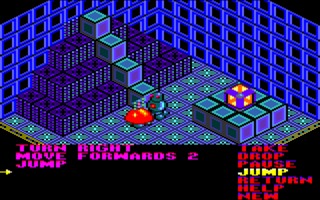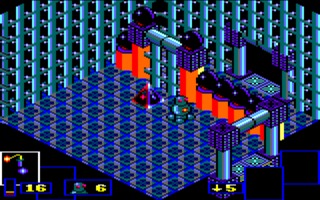Overview
Palitron is a isometric flick-screen game written by Charles Goodwin, who is also responsible for games like Warlock and James Clavell's Shogun. This game was only published for the Amstrad CPC although advertised for other homecomputers. It was re-released by The Edge on two compilations for the Amstrad CPC, in 1987 on the compilation "All-Stars" and in 1988 on the compilation "Classix 1". In Spain the release was undertaken by Erbe Software in 1987.
The back box cover advertises the game with: "Features unique programmable robots, superb 3-dimensional 16 colour display (Amstrad CPC Version) and a host of problems. Probably the best original game written for the Amstrad CPC micros, this game is sure to be a hit on other home micros too."
Story
On a routine surveillance of the Palitron sector, which is located in the Omicron 2 Eridani solar system and is 11.9 light years far away from the good old Mother Terra, the player discovers that all biological life forms have apparently disappeared from what is supposed to be a thriving colony. Furthermore a source of immense power coming from within Palitron City walls can be located and the readings indicate that the presence of several crystal-like formations from another universe is killing all life forms.
The players task is now to track down and to destroy the crystals. But not to be killed either by the alien forms the player activates the remote controlled Servo Class D27 robot which can be guided through Palitron City and obey orders from the player. Some extra help can be obtained by the Infra Class Type 3 robots which are scattered around the city and can be programmed by the player to accomplish difficult tasks.
Gameplay
In search for the matter-destroying crystals hidden around Palitron City the player is in control of a Servo Class D27 robot. The robot can be controlled on Amstrad CPC either by joystick or by keyboard. The pre-defined game controlls can be redefined in the options menu.
The object of the game is to destroy the crystals which can be found at varous locations within the game. This can be done by dropping objects onto the crystals, so that the objects and crystals collide.
But not all objects are able to destroy crystals - here the player will have to experiment.
D27 can be moved on the isometric playground in four directions (up, down, right, left), the robot can also jump and drop or take objects.
 Programming a Infra-Class robot (Amstrad CPC)
Programming a Infra-Class robot (Amstrad CPC)The player will probably find the various Infra-Class Beast Mark 3 robots(small inverted-dish shaped red robots within prominent antennae) scattered around Palitron City a great help. This robots can be reprogrammed by the player to accomplish difficult tasks. In order to operate a Infra-Class robot the player will need to have a energy battery. Standing next with D27 to a Infra-Class robot the player can program the Infra-Class robot by pressing the predefined CTRL-key or activate the robot's program by pressing the predefined TAB-key. 14 commands are available to program the Infra-Class robots.
The various boxes at the bottom of the screen display the players current status as follows:
 Carrying a bomb (Amstrad CPC)
Carrying a bomb (Amstrad CPC)Storage Compartments: The four large boxes display which objects the robot is carrying, so only four objects can be carried at any one time. The box with the white border on the left-hand side of the screen displays the object which will be dropped if the DROP key is pressed.
Energy Gauge: The smaller box on the left-hand side of the screen displays the energy status of the D27 robot. The gauge moves up and down as D27 gains or loses energy. To increase the energy the robot must stand next to a battery and the respective key(predefined it is the TAB-key) must be pressed.
Crystal Gauge: Located next to the Energy Gauge, shows how many crystals remain to be destroyed.
Lives: Located next to the Crystal Gauge, shows how many lives the player has left. The game starts with 6 lives - the practice game just with one.
Drop Objects: This box, which is located on the middle right of the screen, shows the maximum number of objects that can be dropped in the room the robot is currently in. Any room can only contain a maximum of eight objects at any one time, excluding objects being carried.
Bomb Fuse: This box appears at the far right of the screen , when the player has dropped a bomb. It counts down the time remaining before the will bomb explode. So the player has some time to move away the D27 robot from the bomb before it goes off.
Reviews
| Magazine | Issue | Page | System | Rating | % | Reviewer | Language |
|---|
| Amstrad Action | 02/1987 | 54,55 | Amstrad CPC | 89 out of 100 | 89
| BW | English |
| ASM (Aktueller Software Markt) | 03/1987 | 45 | Amstrad CPC | 8.2 out of 12 | 68 | Stefan Swiergiel | German |
| Amstradebdo | 11/1986 | 9 | Amstrad CPC | 6 out of 20 | 30 | - | French |
Log in to comment